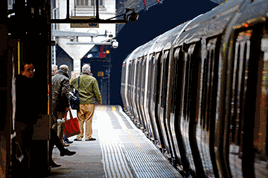Working on the Metropolitan Line, the eight-car train was the first of 191 trains to be delivered. The last trains enter traffic later this year on the District Line. Rollout was completed on the ‘Met Line’ first, with a full fleet of S-Stock trains operating by September 2012, followed by the Circle and Hammersmith & City lines by February 2014.
Because of infrastructure constraints, such as short platforms on the Hammersmith & City and Circle Line platforms at Baker Street, the S-Stock is fitted with Selective Door Opening (SDO). Other platforms have been lengthened to enable the trains to operate. The decision to replace the Circle Line stock ahead of the District Line was also taken because of the condition of the older trains that they were replacing. D-Stock on the District Line had been refurbished in a programme that lasted from 2005 until 2008, and so had plenty of life left in it.
To accommodate the S-Stock, 224 stabling sidings have been modified, and a new stabling facility has been created at Lillie Bridge.
The trains travel on the 300km of Sub‑Surface Lines (SSL). The introduction of the seven-car ‘S7s’ on the Circle and Hammersmith & City lines increased capacity there by 65%, while on the District Line it will rise by 24%. The longer ‘S8s’ increased Metropolitan Line capacity by 27%.
The SSL deal cost £1.5 billion and represents the single biggest rolling stock order in Britain.
The S-Stock design is part of Bombardier’s Movia train family.
Not only are they capable of carrying more passengers than the trains they replaced, but their performance is considerably better, too. While their maximum speed (62mph) may be lower than the trains they replaced, their acceleration is better (2.9mph per second). Such was the difference that during periods of dual-operation S-Stock performance had to be limited to match that of the older trains because of the capability of the infrastructure.
Overall there is an increase of capacity on the S-Stock. An ‘S7’ has capacity for 865 passengers while an ‘S8’ has space for 1,003 passengers. The latter has a reduction of 32% in the number of seats, but that is offset by the fact that many journeys are much shorter on these routes, hence more standing room is required.
The headline feature of the S-Stock trains is the air-conditioning. This is the first time it has been fitted to an LU train. It was possible on the SSL routes because the wider tunnels allow hot air to disperse, plus around 66% of the SSL network runs above the surface. (See feature on pages 100-103). Additionally, the ‘S7s’ and ‘S8s’ are fitted with regenerative braking, which can return 20% of energy that would otherwise be lost back into the power network.
Another method of boosting capacity on the S-Stock trains, is the use of through gangways.
This idea first appeared on TfL’s London Overground Class 378s (also built by Bombardier, in 2009) and is being carried over onto the S-Stock.
This allows passengers to move easily between carriages, and creates extra room for standing passengers. TfL says that through gangways also make passengers feel more secure, as everyone can see along the entire length of the train.
Seating arrangements vary, depending on the train. ‘S7s’ have longitudinal seating only, which reflects the nature of the routes that they serve. ‘Met Line’ ‘S8s’ feature a mixture of longitudinal and bay seating and dedicated wheelchair spaces.
Speaking on December 18 2015, Peter Doolin, Bombardier Transportation’s Vice President Projects, Crossrail & London Underground, said of the S-Stock contract: “It has been an absolute pleasure. We have turned the trains out faultlessly.” He praised the team at Old Dalby, where every train has undergone testing before beginning its LU career, and he highlighted the trains’ reliability statistics, stating: “They are now operating 110,000km between service failures.” This has risen from an average of 75,000km per failure, towards the end of 2014.
Also speaking on the same day, at an event held in Derby, was London Underground Managing Director Nick Brown. He said: “It is a great privilege to be here. My first visit (to Derby) was to look at High Speed Train refurbishments, in 1995.
“The most important people are the passengers, and we know that they enjoy travelling on these trains. The craftsmanship and reliability is so good.”
He says the trains are so reliable that he no longer feels the need to attend performance meetings. “I have stopped going because I know they are performing well.”
He also spoke about how the trains’ air-conditioning was improving travel for people during the summer heat and humidity: “People used them just to cool down.”
He explains: “The last train is due to be delivered towards the end of next year. The D-Stock will then be a thing of the past.”
The S-Stock is the perfect tool for Bombardier to demonstrate its expertise to LU. With 1,700 vehicles introduced onto the Tube since 2009, Bombardier
can boast a considerable pedigree in
the Capital.
- This feature was published in RAIL 793 on February 3 2016
















Login to comment
Comments
Andrewjgwilt1989 - 23/04/2016 00:55
To be fair I do like the S7 & S8 S-Stocks that Bombardier have built over the 6 years they won the contract to build the Movia London Underground Sub Surface trains aswell building the 2009 Stocks for the Victoria Line.
Free Local Classifieds - 04/05/2016 16:42
This design is incredible! You most certainly know how to keep a reader entertained. Between your wit and your videos, I was almost moved to start my own blog (well, almost...HaHa!) Great job. I really enjoyed what you had to say, and more than that, how you presented it. Too cool! Feel free to visit my blog; www.ukclassads.com